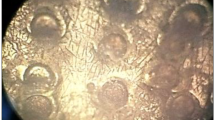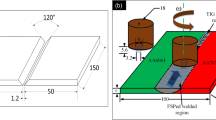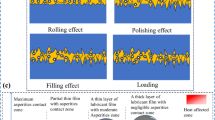Abstract
In engineering applications, many surfaces are manufactured with some specific functional properties such as bearing, sealing, and lubricant retention capabilities. In order to figure out the characteristics of surfaces ground by ultrasonic-assisted grinding, surface bearing index Sbi and core fluid retention index Sci were adopted in this study to investigate the effects of grinding velocity and ultrasonic vibration amplitude on the bearing and fluid retention properties of ground surfaces. Results indicated that the surface bearing index Sbi and core fluid retention index Sci of ultrasonic-assisted grinding (UAG) were larger than those of common grinding (CG) under the same condition. The surface bearing index Sbi decreased with the increase of grinding velocity and increased with the increase of the ultrasonic vibration amplitude, while the core fluid retention index Sci increased with both the grinding velocity and ultrasonic vibration amplitude. Ultrasonic-assisted grinding mechanisms were further explored to interpret these trends. The oscillation in the axial direction generates more overlaps, resulting in relatively flat-top surface. The oscillation in the radial direction generates more intermittent concave, thereby increasing the space for fluid.
Similar content being viewed by others
References
Li C, Zhang F, Meng B, Liu L, Rao X (2016) Material removal mechanism and grinding force modelling of ultrasonic vibration assisted grinding for SiC ceramics. Ceram Int 43(3)
Gong H, Fang FZ, Hu XT (2010) Kinematic view of tool life in rotary ultrasonic side milling of hard and brittle materials. Int J Mach Tools Manuf 50(3):303–307. https://doi.org/10.1016/j.ijmachtools.2009.12.006
Qi H, Wen D, Lu C, Li G (2016) Numerical and experimental study on ultrasonic vibration-assisted micro-channelling of glasses using an abrasive slurry jet. Int J Mech Sci 110:94–107
Abdullah A, Sotoodezadeh M, Abedini R, Fartashvand V (2013) Experimental study on ultrasonic use in dry creep-feed up-grinding of aluminum 7075 and steel X210Cr12. Int J Precis Eng Manuf 14(2):191–198. https://doi.org/10.1007/s12541-013-0027-9
Molaie MM, Akbari J, Movahhedy MR (2016) Ultrasonic assisted grinding process with minimum quantity lubrication using oil-based nanofluids. J Clean Prod 129:212–222
Chen H, Tang J, Zhou W (2013) An experimental study of the effects of ultrasonic vibration on grinding surface roughness of C45 carbon steel. Int J Adv Manuf Technol 68(9–12):2095–2098. https://doi.org/10.1007/s00170-013-4824-1
Tawakoli T, Azarhoushang B (2008) Influence of ultrasonic vibrations on dry grinding of soft steel. Int J Mach Tools Manuf 48(14):1585–1591. https://doi.org/10.1016/j.ijmachtools.2008.05.010
Paknejad M, Abdullah A, Azarhoushang B (2017) Effects of high power ultrasonic vibration on temperature distribution of workpiece in dry creep feed up grinding. Ultrason Sonochem 39:392–402. https://doi.org/10.1016/j.ultsonch.2017.04.029
Chen H, Tang J, Lang X, Huang Y, He Y (2014) Influences of dressing lead on surface roughness of ultrasonic-assisted grinding. Int J Adv Manuf Technol 71(9–12):2011–2015. https://doi.org/10.1007/s00170-014-5636-7
Chen H, Tang J (2016) Influence of ultrasonic assisted grinding on Abbott-Firestone curve. Int J Adv Manuf Technol 86(9–12):2753–2757. https://doi.org/10.1007/s00170-016-8370-5
Wang Y, Lin B, Wang S, Cao X (2014) Study on the system matching of ultrasonic vibration assisted grinding for hard and brittle materials processing. Int J Mach Tools Manuf 77:66–73. https://doi.org/10.1016/j.ijmachtools.2013.11.003
Wang Y, Lin B, Cao X, Wang S (2014) An experimental investigation of system matching in ultrasonic vibration assisted grinding for titanium. J Mater Process Technol 214(9):1871–1878
Wang Q, Zhao W, Liang Z, Wang X, Zhou T, Wu Y, Jiao L (2017) Investigation of diamond wheel topography in elliptical ultrasonic assisted grinding (EUAG) of monocrystal sapphire using fractal analysis method. Ultrasonics 84:87–95. https://doi.org/10.1016/j.ultras.2017.10.012
Liang Z, Wang X, Wu Y, Xie L, Liu Z, Zhao W (2012) An investigation on wear mechanism of resin-bonded diamond wheel in elliptical ultrasonic assisted grinding (EUAG) of monocrystal sapphire. J Mater Process Technol 212(4):868–876. https://doi.org/10.1016/j.jmatprotec.2011.11.009
Shen JY, Wang JQ, Jiang B, Xu XP (2015) Study on wear of diamond wheel in ultrasonic vibration-assisted grinding ceramic. Wear 332-333:788–793. https://doi.org/10.1016/j.wear.2015.02.047
Dong WP, Sullivan PJ, Stout KJ (1994) Comprehensive study of parameters for characterising three-dimensional surface topography III: parameters for characterising amplitude and some functional properties. Wear 178:29–43
Cao J, Wu Y, Lu D, Fujimoto M, Nomura M (2014) Material removal behavior in ultrasonic-assisted scratching of SiC ceramics with a single diamond tool. Int J Mach Tool Manu 79(4):49–61
Li S, Wu Y, Nomura M (2016) Effect of grinding wheel ultrasonic vibration on chip formation in surface grinding of Inconel 718. Int J Adv Manuf Technol 86(1):1113–1125
Cang-Leh C (1994) Wave effects of ultrasonic vibration on machining. The Pennsylvania State University, State College
Funding
The authors gratefully thank the support of the National Natural Science Foundation of China (NSFC) through Grant Nos. 51535012, 51605160, and U1604255, the support of the Key research and development project of Hunan province through Grant No. 2016JC2001, and the open Research Fund of Key Laboratory of High Performance Complex Manufacturing, Central South University (No. Kfkt2016-8).
Author information
Authors and Affiliations
Corresponding author
Rights and permissions
About this article
Cite this article
Chen, H., Tang, J., Shao, W. et al. An investigation on surface functional parameters in ultrasonic-assisted grinding of soft steel. Int J Adv Manuf Technol 97, 2697–2702 (2018). https://doi.org/10.1007/s00170-018-2164-x
Received:
Accepted:
Published:
Issue Date:
DOI: https://doi.org/10.1007/s00170-018-2164-x




